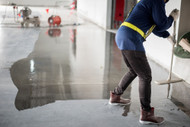When it comes to choosing a flooring material for a factory, there are several factors to consider, such as durability, safety, and ease of maintenance. Epoxy is a popular choice for factory floors due to its unique characteristics and benefits. However, the application process of epoxy coatings can pose health and safety risks to workers if not handled properly. Health and safety is the first aim of the factory owners so that labors or workforce can work in proper health safety.
In this article, we will discuss best practices for ensuring the health and safety of workers during the epoxy application process on factory floors.
1: Proper Ventilation
The application process of epoxy coatings involves the use of chemicals that can release harmful fumes and vapors into the air. These fumes and vapors can cause health issues such as headaches, dizziness, and respiratory problems. It is essential to provide proper ventilation during the application process to ensure that workers are not exposed to these harmful chemicals.
One way to provide proper ventilation is to use fans to circulate fresh air throughout the workspace. Additionally, opening windows and doors can help improve airflow and reduce the concentration of fumes and vapors. It is also important to ensure that the ventilation system is regularly maintained and functioning correctly to provide adequate air circulation.
2: Protective Gear
Workers who are involved in the epoxy application process should wear proper protective gear to minimize their exposure to harmful chemicals. The use of personal protective equipment (PPE) such as gloves, goggles, respirators, and protective clothing can help prevent skin and eye irritation, inhalation of fumes, and other potential health hazards.
The type of PPE required depends on the specific chemicals being used and the level of exposure. It is essential to provide workers with the appropriate PPE and to ensure that they receive proper training on how to use and maintain it correctly.
3: Emergency Response Protocols
Despite taking all necessary precautions, accidents can still happen during the epoxy application process. It is crucial to have emergency response protocols in place to ensure that workers receive prompt medical attention in case of exposure or injury.
These protocols should include the provision of first aid kits, eyewash stations, and emergency showers in the work area. It is also important to have a designated first responder or medical professional available to provide immediate assistance if needed.
4: Training and Education
Finally, one of the most crucial aspects of ensuring the health and safety of workers during the epoxy application process is providing proper training and education. Workers should be trained on the potential health hazards associated with the chemicals used in the epoxy coating and the proper handling, storage, and disposal of these materials.
Training should also include proper procedures for ventilation, PPE use, and emergency response protocols. Workers should have a clear understanding of the risks involved and how to minimize them to ensure their safety and well-being.
Health and Safety Benefits of Proper Epoxy Application on Factory Floors
- Increased Worker Safety: Prioritizing health and safety measures during epoxy application reduces the risk of injuries and illnesses among workers, fostering a safer work environment.
- Reduced Exposure to Harmful Chemicals: Implementing proper ventilation minimizes the accumulation of harmful fumes and vapors, protecting workers from respiratory issues, headaches, and dizziness.
- Minimized Risk of Chemical Burns: Providing personal protective equipment (PPE) such as gloves, goggles, and respirators helps prevent skin and eye irritation, reducing the risk of chemical burns and other injuries.
- Preparedness for Emergencies: Establishing clear emergency response protocols ensures prompt medical attention for workers in case of accidents, minimizing the severity of injuries and exposures.
- Increased Worker Awareness: Comprehensive training and education equip workers with the knowledge to handle epoxy materials safely, understand health hazards, and implement safe practices effectively.
- Improved Air Quality: Regular maintenance of ventilation systems enhances air quality, contributing to a healthier workplace and reducing long-term health risks for employees.
- Increased Compliance with Regulations: Adhering to health and safety guidelines during epoxy application ensures compliance with occupational safety regulations, avoiding potential fines and legal issues.
- Boosted Employee Morale: A commitment to safety fosters a positive work culture, improving employee morale and productivity as workers feel valued and protected.
- Long-term Health Benefits: By minimizing health risks during epoxy application, factories can promote long-term well-being among their workforce, reducing absenteeism and healthcare costs.
By implementing these safety practices, factories can create a safer, healthier environment for their employees during the epoxy application process.
Conclusion
The application process of epoxy coatings on factory floors can pose significant health and safety risks to workers if not handled properly. Providing proper ventilation, protective gear, emergency response protocols, and training and education are crucial to ensuring the health and safety of workers during the epoxy application process. By taking these precautions, factories can minimize the risks associated with epoxy application and provide a safe working environment for their employees.

